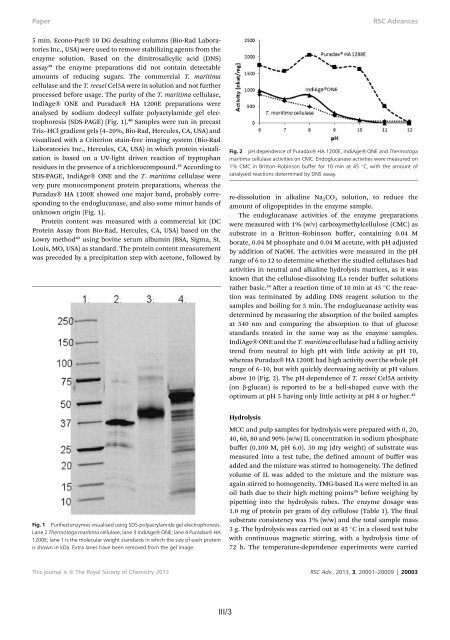Enzymatic hydrolysis of cellulose in aqueous ionic liquids ...
Enzymatic hydrolysis of cellulose in aqueous ionic liquids ...
Enzymatic hydrolysis of cellulose in aqueous ionic liquids ...
Create successful ePaper yourself
Turn your PDF publications into a flip-book with our unique Google optimized e-Paper software.
Paper<br />
5 m<strong>in</strong>. Econo-Pac 10 DG desalt<strong>in</strong>g columns (Bio-Rad Laboratories<br />
Inc., USA) were used to remove stabiliz<strong>in</strong>g agents from the<br />
enzyme solution. Based on the d<strong>in</strong>itrosalicylic acid (DNS)<br />
assay 39 the enzyme preparations did not conta<strong>in</strong> detectable<br />
amounts <strong>of</strong> reduc<strong>in</strong>g sugars. The commercial T. maritima<br />
cellulase and the T. reesei Cel5A were <strong>in</strong> solution and not further<br />
processed before usage. The purity <strong>of</strong> the T. maritima cellulase,<br />
IndiAge ONE and Puradax HA 1200E preparations were<br />
analysed by sodium dodecyl sulfate polyacrylamide gel electrophoresis<br />
(SDS-PAGE) (Fig. 1). 40 Samples were run <strong>in</strong> precast<br />
Tris–HCl gradient gels (4–20%, Bio-Rad, Hercules, CA, USA) and<br />
visualized with a Criterion sta<strong>in</strong>-free imag<strong>in</strong>g system (Bio-Rad<br />
Laboratories Inc., Hercules, CA, USA) <strong>in</strong> which prote<strong>in</strong> visualization<br />
is based on a UV-light driven reaction <strong>of</strong> tryptophan<br />
residues <strong>in</strong> the presence <strong>of</strong> a trichlorocompound. 41 Accord<strong>in</strong>g to<br />
SDS-PAGE, IndiAge ONE and the T. maritima cellulase were<br />
very pure monocomponent prote<strong>in</strong> preparations, whereas the<br />
Puradax HA 1200E showed one major band, probably correspond<strong>in</strong>g<br />
to the endoglucanase, and also some m<strong>in</strong>or bands <strong>of</strong><br />
unknown orig<strong>in</strong> (Fig. 1).<br />
Prote<strong>in</strong> content was measured with a commercial kit (DC<br />
Prote<strong>in</strong> Assay from Bio-Rad, Hercules, CA, USA) based on the<br />
Lowry method 42 us<strong>in</strong>g bov<strong>in</strong>e serum album<strong>in</strong> (BSA, Sigma, St.<br />
Louis, MO, USA) as standard. The prote<strong>in</strong> content measurement<br />
was preceded by a precipitation step with acetone, followed by<br />
RSC Advances<br />
Fig. 2 pH dependence <strong>of</strong> Puradax HA 1200E, IndiAge ONE and Thermotoga<br />
maritima cellulase activities on CMC. Endoglucanase activities were measured on<br />
1% CMC <strong>in</strong> Britton–Rob<strong>in</strong>son buffer for 10 m<strong>in</strong> at 45 C, with the amount <strong>of</strong><br />
catalysed reactions determ<strong>in</strong>ed by DNS assay.<br />
re-dissolution <strong>in</strong> alkal<strong>in</strong>e Na 2 CO 3 solution, to reduce the<br />
amount <strong>of</strong> oligopeptides <strong>in</strong> the enzyme sample.<br />
The endoglucanase activities <strong>of</strong> the enzyme preparations<br />
were measured with 1% (w/v) carboxymethyl<strong>cellulose</strong> (CMC) as<br />
substrate <strong>in</strong> a Britton–Rob<strong>in</strong>son buffer, conta<strong>in</strong><strong>in</strong>g 0.04 M<br />
borate, 0.04 M phosphate and 0.04 M acetate, with pH adjusted<br />
by addition <strong>of</strong> NaOH. The activities were measured <strong>in</strong> the pH<br />
range <strong>of</strong> 6 to 12 to determ<strong>in</strong>e whether the studied cellulases had<br />
activities <strong>in</strong> neutral and alkal<strong>in</strong>e <strong>hydrolysis</strong> matrices, as it was<br />
known that the <strong>cellulose</strong>-dissolv<strong>in</strong>g ILs render buffer solutions<br />
rather basic. 24 Aer a reaction time <strong>of</strong> 10 m<strong>in</strong> at 45 C the reaction<br />
was term<strong>in</strong>ated by add<strong>in</strong>g DNS reagent solution to the<br />
samples and boil<strong>in</strong>g for 5 m<strong>in</strong>. The endoglucanase activity was<br />
determ<strong>in</strong>ed by measur<strong>in</strong>g the absorption <strong>of</strong> the boiled samples<br />
at 540 nm and compar<strong>in</strong>g the absorption to that <strong>of</strong> glucose<br />
standards treated <strong>in</strong> the same way as the enzyme samples.<br />
IndiAge ONE and the T. maritima cellulase had a fall<strong>in</strong>g activity<br />
trend from neutral to high pH with little activity at pH 10,<br />
whereas Puradax HA 1200E had high activity over the whole pH<br />
range <strong>of</strong> 6–10, but with quickly decreas<strong>in</strong>g activity at pH values<br />
above 10 (Fig. 2). The pH dependence <strong>of</strong> T. reesei Cel5A activity<br />
(on b-glucan) is reported to be a bell-shaped curve with the<br />
optimum at pH 5 hav<strong>in</strong>g only little activity at pH 8 or higher. 43<br />
Fig. 1 Purified enzymes visualised us<strong>in</strong>g SDS-polyacrylamide gel electrophoresis.<br />
Lane 2 Thermotoga maritima cellulase; lane 3 IndiAge ONE; lane 4 Puradax HA<br />
1200E; lane 1 is the molecular weight standards <strong>in</strong> which the size <strong>of</strong> each prote<strong>in</strong><br />
is shown <strong>in</strong> kDa. Extra lanes have been removed from the gel image.<br />
Hydrolysis<br />
MCC and pulp samples for <strong>hydrolysis</strong> were prepared with 0, 20,<br />
40, 60, 80 and 90% (w/w) IL concentration <strong>in</strong> sodium phosphate<br />
buffer (0.100 M, pH 6.0). 30 mg (dry weight) <strong>of</strong> substrate was<br />
measured <strong>in</strong>to a test tube, the dened amount <strong>of</strong> buffer was<br />
added and the mixture was stirred to homogeneity. The dened<br />
volume <strong>of</strong> IL was added to the mixture and the mixture was<br />
aga<strong>in</strong> stirred to homogeneity. TMG-based ILs were melted <strong>in</strong> an<br />
oil bath due to their high melt<strong>in</strong>g po<strong>in</strong>ts 35 before weigh<strong>in</strong>g by<br />
pipett<strong>in</strong>g <strong>in</strong>to the <strong>hydrolysis</strong> tubes. The enzyme dosage was<br />
1.0 mg <strong>of</strong> prote<strong>in</strong> per gram <strong>of</strong> dry <strong>cellulose</strong> (Table 1). The nal<br />
substrate consistency was 1% (w/w) and the total sample mass<br />
3 g. The <strong>hydrolysis</strong> was carried out at 45 C <strong>in</strong> a closed test tube<br />
with cont<strong>in</strong>uous magnetic stirr<strong>in</strong>g, with a <strong>hydrolysis</strong> time <strong>of</strong><br />
72 h. The temperature-dependence experiments were carried<br />
This journal is ª The Royal Society <strong>of</strong> Chemistry 2013 RSC Adv., 2013, 3, 20001–20009 | 20003<br />
III/3
















